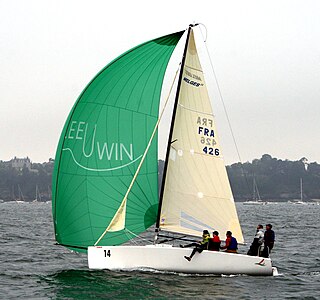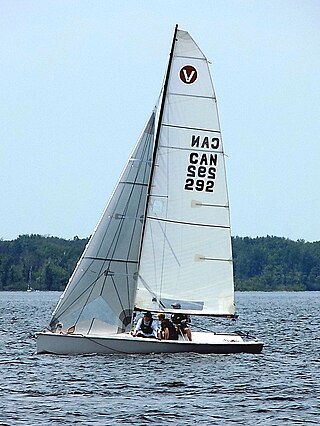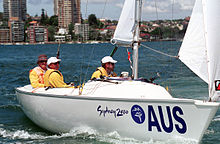
The Moore 24 is an American trailerable sailboat that was designed by George Olson and Ron Moore as a racer and first built in 1972.

The Firefly is a British sailboat that was designed by Uffa Fox as a one design racer and first built in 1946. The boat was originally named the Sea Swallow. It was an Olympic class and raced at the 1948 Olympics.

The Melges 24 is an American trailerable sailboat that was designed by Reichel/Pugh as a one-design racer and first built in 1993.

The Fireball is a British sailing dinghy that was designed by Peter Milne as a one-design racer and first built in 1962.
Bruce Robert William Kirby, was a Canadian-born sailboat designer, dinghy and offshore racer and journalist. His designs spanned in size from the single-handed Laser dinghy to the 12-meter class Louis Vuitton Cup yacht, Canada One. He continued his design work in his American company, Bruce Kirby Marine.

The International FJ is a Dutch sailboat that was designed by Uus Van Essen and Conrad Gülcher as a trainer and one design racer, first built in 1956.

The Flying Fifteen is a British sailboat that was designed by Uffa Fox as a one design racer and first built in 1948.
The Rhodes 19 is an American trailerable day sailer or sailing dinghy, that was designed by Philip Rhodes as a one-design racer and first built in 1958.

The Pearson Ensign, or Ensign 22, is an American trailerable sailboat that was designed by Carl Alberg as a one-design racer and day sailer and first built in 1962. It is the largest full-keel one-design keelboat class in the United States.

The Kirby 25 is a Canadian trailerable sailboat, that was designed by Bruce Kirby as a racer and first built in 1978. The design is out of production.

The Viper 640 is an American trailerable sailboat, that was designed by Brian Bennett for racing and first built in 1996.
The Ideal 18 is a Canadian trailerable sailboat that was designed by Bruce Kirby as a one design racer and first built in 1989.
The Typhoon 18 is a family of American trailerable sailboats that was designed by Carl Alberg as day sailers and cruisers, first built in 1967.
The Impulse 21, also called the Impulse Eagle, is an American trailerable sailboat that was designed by William E. Cook as a one-design racer and day sailer, It was first built in 1986.
The International 210 is an American sailboat that was designed by Fenwick Williams under the supervision of C. Raymond Hunt as a one design racer and first built in 1946.
The Amphibi-Con 25, often just called the Amphibi-Con, is an American trailerable sailboat that was designed by E. Farnham Butler and Cyrus Hamlin as a racer-cruiser and first built in 1954. The design was one of the first "trailer sailers" and helped popularize this class of boat.
The Blazer 23 is a Canadian trailerable sailboat that was designed by Bruce Kirby as racer-cruiser and first built in 1988.
The Seidelmann 25 is an American trailerable sailboat that was designed by Bob Seidelmann as a racer-cruiser and first built in 1977.
Seidelmann Yachts was an American boat builder based in Berlin, New Jersey. The company specialized in the design and manufacture of fiberglass sailboats.
The Seidelmann 24, sometimes called the Seidelmann 24-1, is an American trailerable sailboat that was designed by Bob Seidelmann, Bruce Kirby and W. Ross, as a racer-cruiser and first built in 1981.











